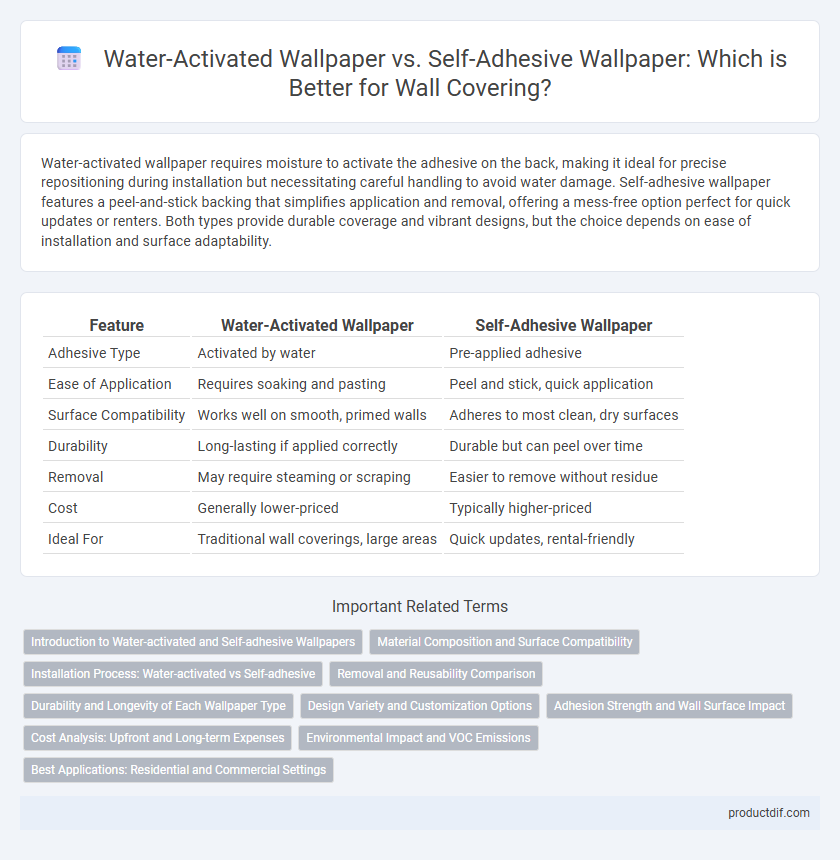Water-activated wallpaper requires moisture to activate the adhesive on the back, making it ideal for precise repositioning during installation but necessitating careful handling to avoid water damage. Self-adhesive wallpaper features a peel-and-stick backing that simplifies application and removal, offering a mess-free option perfect for quick updates or renters. Both types provide durable coverage and vibrant designs, but the choice depends on ease of installation and surface adaptability.
Table of Comparison
| Feature | Water-Activated Wallpaper | Self-Adhesive Wallpaper |
|---|---|---|
| Adhesive Type | Activated by water | Pre-applied adhesive |
| Ease of Application | Requires soaking and pasting | Peel and stick, quick application |
| Surface Compatibility | Works well on smooth, primed walls | Adheres to most clean, dry surfaces |
| Durability | Long-lasting if applied correctly | Durable but can peel over time |
| Removal | May require steaming or scraping | Easier to remove without residue |
| Cost | Generally lower-priced | Typically higher-priced |
| Ideal For | Traditional wall coverings, large areas | Quick updates, rental-friendly |
Introduction to Water-activated and Self-adhesive Wallpapers
Water-activated wallpaper utilizes a starch-based adhesive activated by moisture, offering a traditional application that requires soaking or brushing water onto the backing for adhesion. Self-adhesive wallpaper features a peel-and-stick design with a pressure-sensitive adhesive, enabling quick and mess-free installation without additional paste. Both types provide durable wall coverings but differ significantly in preparation, application methods, and removal ease.
Material Composition and Surface Compatibility
Water-activated wallpaper features a paper base with a starch-based adhesive that activates when moistened, making it ideal for smooth, dry surfaces like drywall and plaster. Self-adhesive wallpaper consists of a vinyl or non-woven fabric backing with a pressure-sensitive adhesive, offering greater flexibility and compatibility with textured surfaces such as wood and metal. Choosing between these options depends on the wall material and desired durability, with water-activated wallpaper being more traditional and self-adhesive providing easier installation.
Installation Process: Water-activated vs Self-adhesive
Water-activated wallpaper requires soaking the backing in water to activate the adhesive, ensuring a strong, smooth bond to the wall but demanding precise timing and handling during installation. Self-adhesive wallpaper features a peel-and-stick backing that allows for quick, mess-free application, ideal for DIY projects and repositioning during installation. Choosing between the two depends on skill level and project needs, with water-activated offering durability and self-adhesive providing convenience.
Removal and Reusability Comparison
Water-activated wallpaper requires thorough soaking to dissolve the adhesive, making removal more labor-intensive but minimizing wall damage, which enhances reusability of both wallpaper and surface. Self-adhesive wallpaper peels off more easily without water, yet often leaves residue that can damage walls and reduce the feasibility of wallpaper reuse. Choosing between the two depends on balancing ease of removal with potential impact on wall integrity and the possibility of repurposing the wallpaper.
Durability and Longevity of Each Wallpaper Type
Water-activated wallpaper typically offers superior durability due to its strong adhesive bond formed upon activation, ensuring long-lasting wall coverage resistant to peeling and moisture. In contrast, self-adhesive wallpaper provides convenience with easy application but may have a shorter lifespan, as the adhesive can weaken over time, especially in high humidity environments. For projects requiring extended longevity and robust performance, water-activated wallpaper remains the preferred choice.
Design Variety and Customization Options
Water-activated wallpaper offers extensive design variety with intricate patterns and textures available in a broad range of colors, making it ideal for customized, high-end interiors. Self-adhesive wallpaper provides flexibility with easy application and removal, featuring diverse prints and customizable sizes suited for temporary or rental spaces. Both options support personalization, but water-activated wallpaper excels in premium finishes, while self-adhesive caters to convenience and quick updates.
Adhesion Strength and Wall Surface Impact
Water-activated wallpaper offers strong adhesion by using a starch-based paste that bonds firmly to porous wall surfaces, minimizing the risk of peeling over time. Self-adhesive wallpaper relies on a pressure-sensitive adhesive that provides instant stickiness but may struggle with uneven or textured walls, potentially leading to bubbles or reduced adhesion strength. Both types can impact wall surfaces differently: water-activated wallpaper may require priming and careful removal to avoid damage, whereas self-adhesive wallpaper is typically easier to remove but can leave adhesive residue or peel paint if not properly applied.
Cost Analysis: Upfront and Long-term Expenses
Water-activated wallpaper generally involves lower upfront costs due to its simple adhesive activation with water, but it requires precise application and may incur higher long-term expenses linked to potential reapplication or damage repairs. Self-adhesive wallpaper demands a higher initial investment due to its pre-applied adhesive backing, yet it offers cost savings over time by simplifying installation and reducing the need for professional help or replacement. Evaluating total cost effectiveness depends on factors like wallpaper quality, installation complexity, and durability in different environments.
Environmental Impact and VOC Emissions
Water-activated wallpaper produces fewer volatile organic compounds (VOCs) during installation compared to self-adhesive wallpaper, which often contains synthetic adhesives that emit higher levels of VOCs harmful to indoor air quality. The environmental impact of water-activated wallpaper is generally lower due to its biodegradable adhesives and minimal reliance on petrochemical-based materials. Choosing water-activated wallpaper supports sustainable indoor environments by reducing toxic emissions and promoting eco-friendly disposal practices.
Best Applications: Residential and Commercial Settings
Water-activated wallpaper excels in commercial settings requiring durability and precision installation, such as hotels and office lobbies where high-traffic durability is essential. Self-adhesive wallpaper offers a convenient solution for residential spaces, allowing easy application and removal ideal for renters or quick decor updates in living rooms and bedrooms. Both types accommodate unique design needs, with water-activated options providing seamless patterns and self-adhesive variants supporting DIY projects and seasonal decor changes.
Water-activated Wallpaper vs Self-adhesive Wallpaper Infographic

 productdif.com
productdif.com